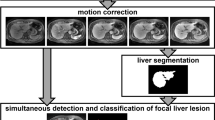Abstract
Purpose
Gadolinium-ethoxybenzyl-diethylenetriamine pentaacetic acid (Gd-EOB-DTPA)-enhanced magnetic resonance imaging (MRI) tends to show higher diagnostic accuracy than other modalities. There is a demand for computer-assisted detection (CAD) software for Gd-EOB-DTPA-enhanced MRI. Segmentation with high accuracy is important for CAD software. We propose a liver segmentation method for Gd-EOB-DTPA-enhanced MRI that is based on a four-dimensional (4D) fully convolutional residual network (FC-ResNet). The aims of this study are to determine the best combination of an input image and output image in our proposed method and to compare our proposed method with the previous rule-based segmentation method.
Methods
We prepared a five-phase image set and a hepatobiliary phase image set as the input image sets to determine the best input image set. We also prepared a labeled liver image and labeled liver and labeled body trunk images as the output image sets to determine the best output image set. In addition, we optimized the hyperparameters of our proposed model. We used 30 cases to train our model, 10 cases to determine the hyperparameters of our model, and 20 cases to evaluate our model.
Results
Our network with the five-phase image set and the output image set of labeled liver and labeled body trunk images showed the highest accuracy. Our proposed method showed higher accuracy than the previous rule-based segmentation method. The Dice coefficient of the liver region was 0.944 ± 0.018.
Conclusion
Our proposed 4D FC-ResNet showed satisfactory performance for liver segmentation as preprocessing in CAD software.




Similar content being viewed by others
References
Akai H, Kiryu S, Matsuda I et al (2012) Detection of hepatocellular carcinoma by Gd-EOB-DTPA-enhanced liver MRI: comparison with triple phase 64 detector row helical CT. Eur J Radiol 80(2):310–315
Berger-Kulemann V, Schima W, Baroud S et al (2012) Gadoxetic acid-enhanced 30 T MR imaging versus multidetector-row CT in the detection of colorectal metastases in fatty liver using intraoperative ultrasound and histopathology as a standard of reference. Eur J Surg Radiol 38(2):670–676
Takenaga T, Hanaoka S, Nemoto M et al. (2017) Segmentation of liver region in Gd-EOB enhanced magnetic resonance images. In: Proceedings of IFMIA 2017 the international forum medical imaging in Asia, Okinawa, pp 19–20
Huynh HT, Le-Trong N, Oto A, Suzuki K (2017) Fully automated MR liver volumetry using watershed segmentation coupled with active contouring. Int J Comput Assist Radiol Surg 12(2):235–243
Oh J, Martin DR, Hu X (2014) Partitioned edge-function-scaled region-based active contour (p-ESRAC): automated liver segmentation in multiphase contrast-enhanced MRI. Med Phys 41(4):219–244
Christ PF, Ettlinger F, Grun F et al (2017) Automatic liver and tumor segmentation of CT and MRI volumes using cascaded fully convolutional neural networks. arXiv:1702.05970v2
Lee J, Kim KW, Kim S et al (2014) Feasibility of semiautomated MR volumetry using gadoxetic acid–enhanced MRI at hepatobiliary phase for living liver donors. Magn Reson Med 72(3):640–645
Drozdzal M, Chartrand G, Vorontsov E et al (2018) Learning normalized inputs for iterative estimation in medical image segmentation. Med Image Anal 44:1–13
Glocker B, Sotiras A, Komodakis N, Paragios N (2011) Deformable medical image registration: setting the state of the art with discrete methods. Annu Rev Biomed Eng 13:219–244
Kingma DP, Ba J (2017) Adam: a method for stochastic optimization. arXiv:1412.6980
Bergstra J, Bengio Y (2012) Random search for hyper-parameter optimization. J Mach Learn Res 13:281–305
Chainer. http://chainer.org/. Accessed 6 September 2018
Wan SY, Higgins WE (2003) Symmetric region growing. IEEE Trans Image Process 12:1007–1015
Isensee F, Jaeger PF, Full PM, et al (2017) Automatic cardiac disease assessment on cine-mri via time-series segmentation and domain specific features. In: International workshop on statistical atlases and computational models of the heart, pp 120–129
Author information
Authors and Affiliations
Corresponding author
Ethics declarations
Conflict of interest
The authors declare no conflicts of interest with regard to the present study.
Rights and permissions
About this article
Cite this article
Takenaga, T., Hanaoka, S., Nomura, Y. et al. Four-dimensional fully convolutional residual network-based liver segmentation in Gd-EOB-DTPA-enhanced MRI. Int J CARS 14, 1259–1266 (2019). https://doi.org/10.1007/s11548-019-01935-z
Received:
Accepted:
Published:
Issue Date:
DOI: https://doi.org/10.1007/s11548-019-01935-z




